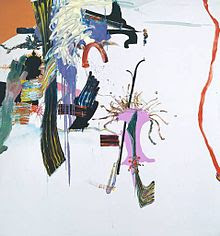'Catherine to Claire', Richard Diebenkorn
I’ve
been mulling over lots of things lately with regards to my painting (I’m a good
muller. Sometimes it is the only thing I can or have the time to do when the
pressures of work and family take over). I’ve also seen a few good exhibitions,
and been trying some new things.
One of
these included a recent staff development in mixed media painting lead by
artist Jenny Muncaster. I’m not very experienced in mixed media painting as it
is something I’ve not had much interest in relation to my own work. Despite having
a BA (Hons) and MA in Fine Art, Painting, like most artists much of what I’ve
learned in the craft of my practice is self-taught and lead by my personal interests.
Anyway, I really enjoyed the day and really found Jenny’s enthusiasm inspiring,
and discovered lots of new techniques, which my students have been trying with
great gusto ever since. It’s really opened up their work, and broadened my own
delivery of teaching painting, which is what I was seeking.
So many
artists/lecturer say you can’t ‘teach’ painting, meaning students either have it or they don’t, but I think this is a load of nonsense and history proves this. It’s
just a lazy and unimaginative attitude to teaching. The more formal teaching
I’ve received is the stuff that has carried me furthest, and this approach
underlies much of my own work with students. It’s the poetry that is harder to
teach.
Richard Diebenkorn
Much of
the work with Jenny involved building up the surface of the painting using
layers of paint and texture. I’ve enjoyed doing this too, and some of this is
creeping up into some of my experiments in the studio as I begin to develop
some of the work made in Scandinavia with greater conviction. Some of these are
also influenced by the paintings of Richard Diebenkorn, who has appeared more
seriously on my radar of influences lately. A recent visit to the studio by artist
Hugh Marwood picked up on the shared ‘zones’ of colour (a major trait in
Diebenkorn’s paintings, as well as the layered surfaces) and tonal banding in
the motorway and Scandinavian paintings, which I found an encouraging
connection. It’s helped me pick up and start to take these things on as a
starting point. Liz Hawley, the arts consultant I’m currently working with, also
commented last week that the Scandinavian paintings were also just as rooted in
the edgelands, both geographically and psychologically, which I hadn’t been
seeing. This feedback is great and spurs me on.
I went
with Liz to see a small exhibition of painting at Nottingham Castle last week.
The work was from the studios of local Nottingham painters, and had some great
qualities and a serious engagement with the media on one hand, but much of the
style and subject matter however, seemed to epitomize much of the concerns
currently floating around: a deliberately off-handed, loose handling built on
naïve illustrative drawing and lots of images of animals or creatures involved
in some obscure narrative setting- a bit folk arty and a bit quirky. A bit
predictable too. Still, it was good to see evidence of what appeared to be a more
vibrant and collective painting scene than exists in Birmingham.
'Labroffesson', Thomas Fearnley, oil on canvas, 1836
Thomas Fearnley
The
same could be said of the Fiona Rae exhibition over at New Art Gallery, Walsall
which I also enjoyed. Full of complex and playful formal ideas, these large
scale and colourful paintings really celebrate the endless possibilities of
painting as a continuing creative mode of expression.
Fiona Rae, 'Untitled (Yellow), oil and acrylic on canvas, 1993
I’ve
seen many exhibitions of Rae’s work over the years, and I must admit I prefer
the qualities that seemed to exist in the earlier works, where the skidding and
slipping marks seemed to possesses a less self-conscious autonomy, than the
ones on display in Walsall which feel more deliberately constructed or ‘built’.
There were two paintings though, a little smaller than the others and better
for it, which seemed to have been over-worked, more heavily-laden with paint
and surface, that tipped into a more uncomfortable, almost ugly state of being that
I thought were much more interesting. Their scale seemed to confront you more
at eye-level which I found unsettling and gave them a much more powerful
presence in the room. I’m thinking a lot about scale at the moment….
'As I Run And Run Happiness Comes', Fiona Rae, oil and acrylic on canvas, 2009
I've been revisiting Counting Crows' 'August and Everything After' album lately. It's on heavy rotation at home, in the studio, and on the i-pod. With sublime songs like 'Round Here', 'Time and Time Again', 'Rain King', 'Sullivan Street', and well, all of them basically, it just seems the perfect record to lose myself in the last month or so...







No comments:
Post a Comment